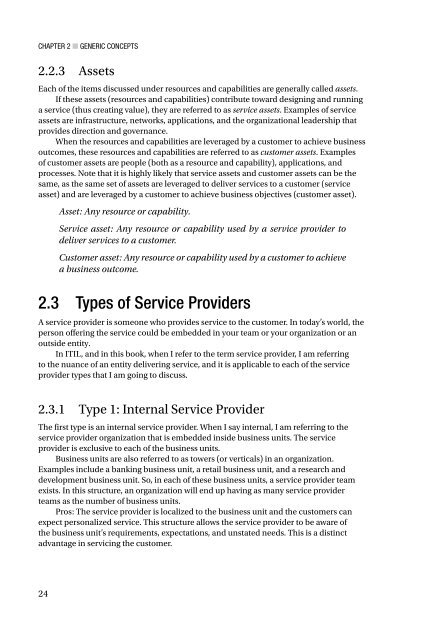become-itil-foundation-certified-abhinav-kaiser(www.ebook-dl.com)
Create successful ePaper yourself
Turn your PDF publications into a flip-book with our unique Google optimized e-Paper software.
Chapter 2 ■ Generic Concepts<br />
2.2.3 Assets<br />
Each of the items discussed under resources and capabilities are generally called assets.<br />
If these assets (resources and capabilities) contribute toward designing and running<br />
a service (thus creating value), they are referred to as service assets. Examples of service<br />
assets are infrastructure, networks, applications, and the organizational leadership that<br />
provides direction and governance.<br />
When the resources and capabilities are leveraged by a customer to achieve business<br />
out<strong>com</strong>es, these resources and capabilities are referred to as customer assets. Examples<br />
of customer assets are people (both as a resource and capability), applications, and<br />
processes. Note that it is highly likely that service assets and customer assets can be the<br />
same, as the same set of assets are leveraged to deliver services to a customer (service<br />
asset) and are leveraged by a customer to achieve business objectives (customer asset).<br />
Asset: Any resource or capability.<br />
Service asset: Any resource or capability used by a service provider to<br />
deliver services to a customer.<br />
Customer asset: Any resource or capability used by a customer to achieve<br />
a business out<strong>com</strong>e.<br />
2.3 Types of Service Providers<br />
A service provider is someone who provides service to the customer. In today’s world, the<br />
person offering the service could be embedded in your team or your organization or an<br />
outside entity.<br />
In ITIL, and in this book, when I refer to the term service provider, I am referring<br />
to the nuance of an entity delivering service, and it is applicable to each of the service<br />
provider types that I am going to discuss.<br />
2.3.1 Type 1: Internal Service Provider<br />
The first type is an internal service provider. When I say internal, I am referring to the<br />
service provider organization that is embedded inside business units. The service<br />
provider is exclusive to each of the business units.<br />
Business units are also referred to as towers (or verticals) in an organization.<br />
Examples include a banking business unit, a retail business unit, and a research and<br />
development business unit. So, in each of these business units, a service provider team<br />
exists. In this structure, an organization will end up having as many service provider<br />
teams as the number of business units.<br />
Pros: The service provider is localized to the business unit and the customers can<br />
expect personalized service. This structure allows the service provider to be aware of<br />
the business unit’s requirements, expectations, and unstated needs. This is a distinct<br />
advantage in servicing the customer.<br />
24


